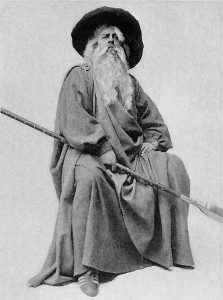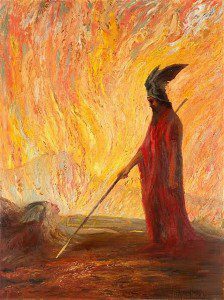
Being raised in a heathen family, one would think that my relationship with Odin would have been formed many years ago. In all honesty, however, it was an evolutionary process over the course of my adult years that I really came to know him. When I was a child, we would honor him along with the other deities during specific times of the year, usually Midsummer and Yule. I read the Eddas early on, and though I knew the stories as a youngster, it wasn’t until much later that I was able to really look at the symbolism behind them. I thought of the gods as the people next door, out of sight but still close and very real. I didn’t give much thought about their attributes of fertility, agriculture, protection, or their involvement in the world of Midgard.
As a young adult just starting college, I met friends of every faith and realized that those who had grown up going to church had been taught a spiritual side to their faith that I had somehow missed. Where they were sometimes lacking in seeing divinity in a realistic sense, I was at times at a loss for seeing my gods in a spiritual one. It wasn’t until that I began a dialogue with those of other faiths that I really saw this and it led me to make very deliberate choices later in my life.
For instance, I was aware of what galdr was but had never practiced it. I had heard of the runes “calling” to others, but had never taken the time to form a relationship with the runes myself. I began studying the runes deeply and dedicated myself to practicing and meditating with them daily. I drew them on paper, I carved them, and I held them one by one in my hand until I had meditated with each one independently many times. I studied their basic meanings, I learned to listen rather than ask, and I then began to take notes on what I felt their deeper meanings were. I realized that the runes each had their own spirit, so to speak, and definitely possessed their own energies that could be directed in both positive and negative ways. I asked Odin to guide me, and gave my word that if he would help lead me in the right directions to gain runic wisdom that I would in turn help others.
I didn’t realize at the time that years later, I would become a gythia and workshop leader. I never imagined speaking to large crowds on establishing a relationship with the Northern gods, but that’s where he needed me to be. It was working with the runes, and the willingness to practice them with a certain mindfulness that helped me find my personal spiritual path. That one choice, to know my faith on a deeper spiritual level, changed my life.
I began to contemplate the symbolism behind the lessons that Odin teaches us. When he sacrificed himself, to himself, upon Yggdrasil, he showed that self-sacrifice for the greater good was a component of coming through a difficult transition in the course of life. He demonstrated the dark, hard part of the natural cycle – accepting that death and rebirth are part of life, and that to every living thing that there is a delicate order. It’s a certainty, and one that we must not only accept, but overcome with a sense of peace.
Odin’s sacrifice also showed me that he knew what it was like to be “without”. The Havamal tells us that he hung on Yggdrasil with no food or water, no help from anyone. It hit me how alone that must have felt, and yet he knew it was necessary and accomplished what he set out to do. We are often in the same position. Hard decisions are not new to many of us, and bravery cannot be a luxury that we deny ourselves. In order to achieve our highest, we need to dig deep into the low and bring forth the lesson even if it means that we do it alone or without all of the tools that we’d like to have available. Odin may have liked a draught of mead, but none was given. It certainly would’ve renewed his strength, and perhaps his emotional energy, but he did without, and so must we too sometimes. In absence, something fulfilling can be gained, and we become especially thankful for the tools and support that we do have in other parts of our lives.

If we were always surrounded by loving encouragement, we’d never know how to pull from within nor could we truly appreciate inner solitude. On the opposite side of the coin, if we spend all of our time alone, then we deny ourselves the joy and pleasure of what it feels like to be comforted, amused, or otherwise happy when we have a few good friends. It’s a balance, a part of that delicate order I mentioned.
Over the years, my relationship with Odin has grown in many ways. He has shown time and again that he’s receptive to those who come with the right heart and mind, wanting to fulfill their calling in life and honoring the gods as they pursue that. There have been times when he’s taken my hand gently, and times when if it hadn’t been for his insistence, I would have firmly rooted myself where I was and resolved to grow no further. He has played an integral part of me realizing what is expected of me spiritually, physically, and mentally.
My own path is dedicated to taking my commitment and what I’ve learned as far as I’m able, in the hopes that when I stand before the counsel one day at the end of my life, Odin will have seen enough to let him know that I kept my oath to him and to the values that my faith holds sacred. Sometimes we dance, sometimes we walk, sometimes I argue — but Odin is with me and I with him.
Heathen Woman is published on alternate Fridays. Subscribe via RSS or e-mail!

















